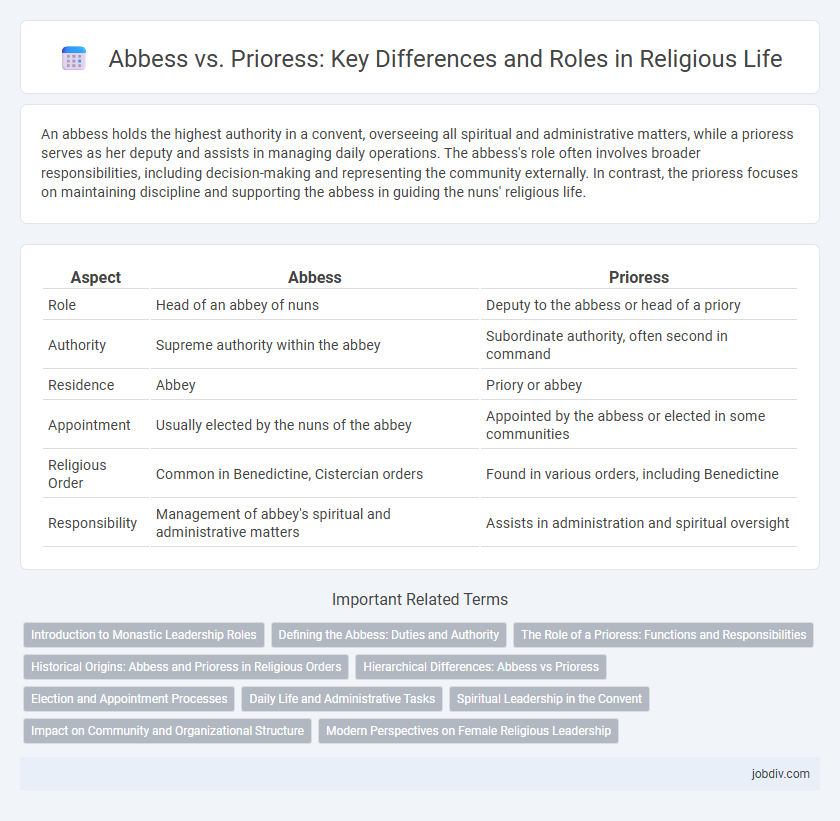An abbess holds the highest authority in a convent, overseeing all spiritual and administrative matters, while a prioress serves as her deputy and assists in managing daily operations. The abbess's role often involves broader responsibilities, including decision-making and representing the community externally. In contrast, the prioress focuses on maintaining discipline and supporting the abbess in guiding the nuns' religious life.
Table of Comparison
| Aspect | Abbess | Prioress |
|---|---|---|
| Role | Head of an abbey of nuns | Deputy to the abbess or head of a priory |
| Authority | Supreme authority within the abbey | Subordinate authority, often second in command |
| Residence | Abbey | Priory or abbey |
| Appointment | Usually elected by the nuns of the abbey | Appointed by the abbess or elected in some communities |
| Religious Order | Common in Benedictine, Cistercian orders | Found in various orders, including Benedictine |
| Responsibility | Management of abbey's spiritual and administrative matters | Assists in administration and spiritual oversight |
Introduction to Monastic Leadership Roles
Abbess and prioress are key monastic leadership roles within religious communities, primarily in convents and monasteries following the Benedictine or similar traditions. An abbess serves as the elected superior and spiritual guide of an abbey, holding full authority over the nuns and the administrative functions, while a prioress often acts as her deputy or leads a priory, a dependent or smaller religious house. These roles are essential for maintaining discipline, spiritual growth, and operational management in monastic life.
Defining the Abbess: Duties and Authority
The abbess holds the highest authority within a female monastic community, governing the abbey and overseeing spiritual and administrative duties. Her responsibilities include managing the convent's daily operations, maintaining discipline among nuns, and representing the abbey in external ecclesiastical matters. Unlike a prioress, who serves as the deputy or leader of a priory, the abbess possesses full jurisdictional power and autonomy granted by the church hierarchy.
The Role of a Prioress: Functions and Responsibilities
A prioress serves as the deputy to the abbess, overseeing daily monastery operations and ensuring adherence to religious rules and disciplines. She manages the convent's internal affairs, including the welfare of nuns, discipline enforcement, and coordination of prayers and communal activities. The role demands strong leadership to maintain spiritual focus and operational efficiency within the religious community.
Historical Origins: Abbess and Prioress in Religious Orders
The abbess and prioress both originate from monastic traditions within Christian religious orders, with the abbess serving as the female superior in abbeys, historically entrusted with greater authority and governance over large monastic communities. The prioress, often subordinate to the abbess, typically led smaller priories or assisted in administrative duties, evolving in distinct roles across Benedictine, Cistercian, and other religious orders from the early medieval period. These titles reflect the hierarchical structure and spiritual leadership roles designated for women in convents, emphasizing the development of female monastic authority since the 6th century.
Hierarchical Differences: Abbess vs Prioress
An abbess holds the highest authority within a convent, overseeing all spiritual, administrative, and disciplinary matters, whereas a prioress acts as her deputy or leads smaller priories with less autonomy. The hierarchical distinction positions the abbess as the principal superior, often elected by the community, while the prioress typically reports to the abbess or governs when no abbess is appointed. This difference in rank reflects broader ecclesiastical traditions where the abbess embodies full governance, and the prioress serves a subordinate or provisional leadership role.
Election and Appointment Processes
Abbesses are typically elected by the convent's nuns through a formal voting process, reflecting the community's choice for spiritual and administrative leadership. Prioresses may be either elected by the choir nuns or appointed by the abbess or higher ecclesiastical authority, depending on the specific monastic order's rules. Election and appointment procedures emphasize communal consent and canonical approval to ensure legitimate governance within monastic hierarchy.
Daily Life and Administrative Tasks
An abbess leads a convent with full authority, overseeing both spiritual guidance and administrative management, including budgeting, discipline, and external relations. A prioress serves as a deputy to the abbess or heads a priory, handling daily routines and internal community affairs but with limited administrative power. Their daily life includes managing prayer schedules, supervising the sisters' work, and ensuring adherence to monastic rules.
Spiritual Leadership in the Convent
The abbess holds the highest authority in a convent, overseeing both spiritual guidance and administrative duties, embodying a role of profound leadership within the community. The prioress, as second in command, supports the abbess by managing daily affairs and providing spiritual mentorship to the nuns. Both positions serve as vital pillars of spiritual leadership, fostering discipline, prayer, and religious observance in the convent.
Impact on Community and Organizational Structure
Abbess and prioress roles significantly shape monastic community dynamics, with the abbess holding supreme authority, often overseeing larger abbeys with autonomous governance, while the prioress typically manages smaller priories or acts as deputy under an abbess. The abbess's leadership fosters a centralized organizational structure that impacts decision-making, resource allocation, and spiritual guidance more broadly, whereas the prioress supports daily operations and community discipline within a more limited scope. These distinctions influence how religious communities maintain order, address the needs of members, and engage with external ecclesiastical authorities.
Modern Perspectives on Female Religious Leadership
Modern perspectives on female religious leadership highlight distinct roles between abbesses and prioresses within monastic communities, with abbesses typically holding higher authority as heads of abbeys, overseeing spiritual and administrative duties. Prioresses often serve under abbesses or lead smaller priories, focusing on day-to-day community management and fostering spiritual growth. Contemporary religious discourse increasingly emphasizes the evolving leadership capacities of both roles, recognizing their contributions to female empowerment and organizational sustainability in religious institutions.
Abbess vs Prioress Infographic

 jobdiv.com
jobdiv.com